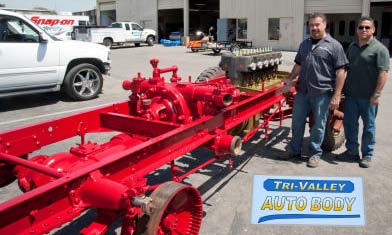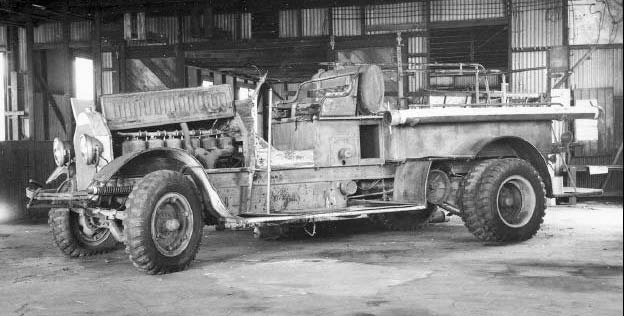
SEAGRAVE RESTORATION PROCESS
In 2008, after completing the restoration of the 1919 Ford Model T, Chuck Mc Fann spoke with Bill Junk about starting the restoration of the Seagrave. Bill approved the work,and the restoration began in September, 2008. Chuck solicited help from several friends to bring the rusty, dilapidated fire truck back to its original beautiful condition. The plan was to restore the truck to parade quality, a term that is ill-defined, but implies a quality that can be both admired and utilized by the community for festive events and parades.
The photo above shows the Seagrave as the restoration crew found her when work began. It lacked its original electrical generator (presumably borrowed by someone doing a similar Seagrave restoration), fire bell, siren, spotlight, driver’s seat upholstery (destroyed by sitting outdoors in bright sun and rain for 35 years), and the steering wheel (only the metal spokes remained). However, nearly all the structural metal remained un-rusted.
The initial stage of the restoration was creating a photographic inventory of the machine as it existed. We supplemented this photographic inventory when we located a fully restored 1915 Seagrave in Hayward, and a 1921 Seagrave in San Mateo. We visited these vehicles and established a working relationship with the owners. Figure 5 shows the Seagrave as the restoration crew found her when work began. It lacked its original electrical generator presumably borrowed by someone doing a similar Seagrave restoration), fire bell, siren, spotlight, driver's seat upholstery (destroyed by sitting outdoors in bright sun and rain for 35 years), and steering wheel (only the metal spokes remained). However, nearly all of the structural metal remained un-rusted.
We also found a restored 1920 Seagrave in Redlands, Calif. The owners have taken quite an interest in our work and have driven from southern California just to observe our progress. Apparently they were able to have their truck restored by inmates of a local prison.
Disassembly of the entire truck was the initial task. This was frustrated by rusted bolts, very tight valve covers, and a lack of space to store all of the parts as they were removed. Having a group of volunteers who are diversely talented has been key to the success of our restoration efforts. Jim Boehmke, highly skilled in the art to sheet metal work was very successful at removing dents and straightening seam lines. Fred Deadrick, a skilled woodworker, was able to recreate the original steering wheel which had been nearly entirely destroyed by years of sunlight and rain. Based on a few scraps of wood from the original steering wheel found in the drivers seat by Susan Junk, he was able to remanufacture a new wheel.
Many frozen and rusted components required a gas torch to break them free and then careful wire brushing, sanding, and buffing to restore the surface finish. One valve cover was so frozen in place that it resisted unscrewing for nearly a month until finally a special tool was fabricated which required four strong men to turn.It now works flawlessly.
Jeff Kaskey persuaded the owners of the Tri-Valley Auto Body shop to voluntarily take on the task of professionally painting the truck. They went out of their way by convincing Ned's Auto Body Supply,Inc. to donate the paint for the truck. Disassembly proceeded for nearly 6 months to where all of the sheet metal parts were ready for painting. After careful painting and buffing the sheet metal parts were carefully stored in the old library building on South Livermore Avenue.
With the sheet metal removed, the ninety-year-old chassis remained to be restored. It was caked with old dirt and grease which required extensive scraping and then steam cleaning provided by Kevin Nista at Early Years and Exotics. Once the chassis was spotless and completely grease free, it also was transported to Tri-Valley Auto Body for final painting. On the right is the completed chassis along with George Romero and his brother “J.R.”.

With the chassis now painted and the critical drive train components carefully examined and repaired, the restoration crew is anxiously awaiting the reinstallation of all the engine hardware (intake and exhaust manifolds, carburetor, distributor, starter motor, generator and electrical wiring), and then the dramatic restarting of the engine after nearly 50 years of silence can begin. Hopefully this first restarting will be accomplished sometime in the fall of 2010.
methodical process of locating several missing components. An old Seagrave generator m was located on eBay and restored by Dean’s Auto Electric shop here in Livermore. A Seagrave Fire Bell was also found on eBay and has been buffed to perfection. The old dented headlights have been worked back to shape and nickel plated. A professional upholsterer was located and persuaded to restore the leather driver’s seat to original condition. Merv Nichols has restored the magneto ignition system, and Jim Boehmke restored the German Silver radiator to sparkling condition. All wheel bearings have been examined and repacked with grease, and six new tires have been purchased and are awaiting being mounted on the recently painted wheels.
What Happened Next
One of the most distinctive features of old fire trucks was the gold leaf decoration applied by skilled professionals. This is actual gold metal foil (very thin) carefully applied and then lacquered in place to protect the gold. Randy Jennings, a local gilder (and former fireman), worked with our restorers to apply all of the straight gold pin striping to the chassis, and worked to identify an even more skilled gilder to apply the more exotic gold leafing to the engine hood,and side panels. The Guild has also been fortunate to identify Lance Cavalieri and John and Sue Houghton, who volunteered to supply the gold foil necessary for the filigree and pin striping. We held a major fund raising effort to collect $15,000 to assure completion of the restoration in 2011. Final assembly of the bodywork depended upon the rate at which we could pay the gilder to decorate the body.
The restoration crew works every Saturday morning at the Duarte (Lincoln Highway) Garage, and visitors not afraid of a little work are always welcome.
Newsletter Articles
"The Revival of Livermore 1920 Seagrave Fire Engine" 2010.07
"Seagrave Fire Engine Restoration Nears Completion" 2012.01

